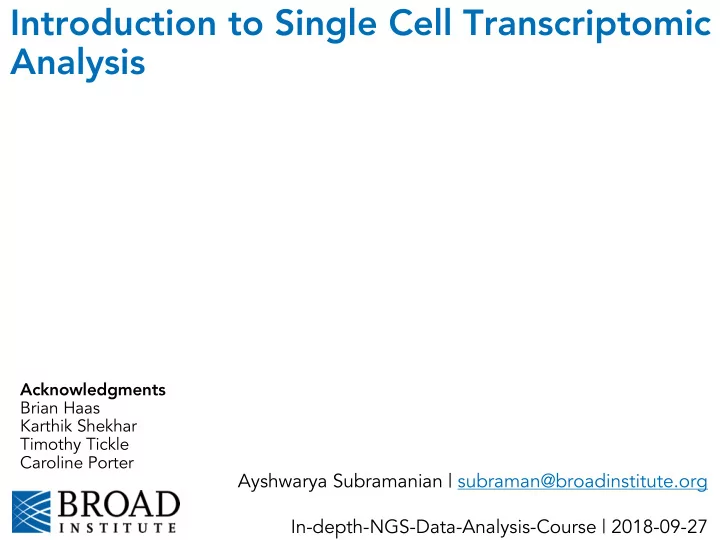

Determining cell type, state, and/or function: 2. Dimensionality reduction Identifying maximal orthogonal • PCA is a dimensionality sources of variation reduction method that transforms a set of observations into a set of linearly uncorrelated variables called principal components • The first principal component contains the most variance, and each component after contains as much variance while still being orthogonal to other components 60 From: https://stats.stackexchange.com/questions/2691/making-sense-of-principal-component-analysis-eigenvectors-eigenvalues
Determining cell type, state, and/or function: 2. Dimensionality reduction PCA of single cell data ● PC1 separates the red cells from the pink, orange, and green cells 61 ● PC2 separates the green cells from the red, pink, and orange cells
Determining cell type, state, and/or function: 2. Dimensionality reduction PCA of single cell data ● PC3 further splits off the orange cells 62
Determining cell type, state, and/or function: 2. Dimensionality reduction PCA of single cell data tSNE: t- distributed Stochastic Neighbor Embedding ● tSNE is nonlinear dimensionality reduction 63 ● tSNE collapse the visualization to 2D
Dimensionality Reduction •Start with many measurements (high dimensional). Want to reduce to few features (lower- - dimensional space). •One way is to extract features based on capturing groups of variance. •Another could be to preferentially select some of the current features. We have already done this. - •We need this to plot the cells in 2D (or ordinate them) •In scRNA-Seq PC1 may be complexity or technical.
PCA: Overview •Eigenvectors of covariance matrix. •Find orthogonal groups of variance. •Given from most to least variance. Components of - variation. Linear combinations - explaining the variance.
PCA: in Practice Things to be aware of- •Data with different magnitudes will dominate. Zero center and divided by SD. - •(Standardized). •Can be affected by outliers. •Data is often first filtered to remove noise.
PCs Notice how lower PCs look more and more “spherical” - this loss of structure indicates that the variation captured by these PCs mostly reflects noise.
How Many Components Should We Use? Elbow Plot (Scree Plot)
3. Visualization 6 Slide adapted from Karthik Shekhar 9
t-SNE: Collapsing the Visualization to 2D
t-SNE: Nonlinear Dimensionality Reduction
t-SNE: How it Works
PCA and t-SNE Together •Often t-SNE is performed on PCA components Liberal number of components. - Removes mild signal (assumption of noise). - Faster, on less data but, hopefully the same - signal.
Plotting Metadata on Ordinations X ✅ Metadata ✅ Gene X Expression
Caution When Interpreting t-SNE Nonlinear Optimized for local distanct Big clusters can just mean more cells.
Learn More About t-SNE •Awesome Blog on t-SNE parameterization http://distill.pub/2016/misread-tsne - •Publication https://lvdmaaten.github.io/publications/papers/ - JMLR_2008.pdf •Nice YouTube Video https://www.youtube.com/watch?v=RJVL80Gg3l - A •Code https://lvdmaaten.github.io/tsne/ - •Interactive Tensorflow http://projector.tensorflow.org/ -
4. Clustering cells to identify cell-types 7 Andrews TS and Hemberg M. Mol Aspects Med. 2018 7
Defining Clusters Through Graphs
Local Moving Heuristic
Tirosh and Izar et al. Science 2016 80 Shekhar et al. Cell 2016
Determining cell type, state, and/or function: 3. Visualization 81 A great tSNE resource! https://distill.pub/2016/misread-tsne/
Single-cell RNA-seq analysis pipeline: Analyzing the expression data Pre-Processing Clustering Biology 1. Expression Matrix 1. Identify 5. Differentially (GENES x CELLS) Variable Genes Expressed Genes 2. Filter Cells / 2. Dimensionality 6. Assigning Quality Control Reduction Cell Type 3. Exploring Known 7. Functional 3. Normalization Marker Genes Annotation 4. Clustering 82
5. Assigning cell identity & comparing across conditions: Differential Expression Analysis Soneson and Robinson. Nat Methods 2018 83 Haber, Moshe and Rogel et al. Nature 2017
Determining cell type, state, and/or function: 5. Identifying differentially expressed genes Bulk Single cell 84
Differential Expression
Single Cell Differential Expression (SCDE)
MAST •Uses hurdle model Two part generalized - linear model to address both rate of expression (prevalence) and expression. GLM means covariates - can be used to control Additionally introduces a for unwanted signal. GSEA method •CDR: Cellular detection rate Cellular complexity - https://github.com/RGLab/MAST Values below a threshold - are 0
MAST: Hurdle Models
Seurat: Differential Expression •Default if one cluster again many tests. Can specify an ident.2 test between clusters. - •Adding speed by excluding tests. Min.pct - controls for sparsity - Min percentage in a group - Thresh.test - must have this difference in - averages.
Seurat: Many Choices of DE Bimod - Tests differences in mean and proportions. Roc - Uses AUC like definition of separation. T - Student's T-test. Tobit - Tobit regression on a smoothed data. MAST - Hurdle model for zero inflated data ….
6. Assigning cell identity: Known marker genes Shekhar et al. Cell 2016 91 Park and Shreshtha et al. Science 2018
Determining cell type, state, and/or function: Exploring expression of marker genes 92
Determining cell type, state, and/or function: 6. Assigning cell type 93
Visualizing genes of interest Dot plots, violin plots, feature plots prevalent genes sparse genes Size of circle • Gene prevalence in cluster Color of circle • More red, more expressed in cluster Scales well with many cells lowly highly very 94 expressed expressed specific
Determining cell type, state, and/or function: .Identifying differentially expressed genes Genes Cell clusters 95
Visualizing genes of interest Dot plots, violin plots, feature plots 96
Gene signatures can be used to score each cell based on a set of genes ● Can visualize a score for each cell and look at multiple genes at once ● Done for a gene expression program of interest, e.g, cell-cycle, inflammation, cell type, dissociation ● Reduces the effects of dropouts Gene signature for T cells 97
Visualizing genes of interest Dot plots, violin plots, feature plots 98
7. Functional annotation by pathway analysis and gene-set enrichment analysis 99 Shekhar et al. Cell 2016
Trajectory inference Diffusion pseudotime Diffusion Maps Bach et al. Nat Comm 2016 100 Haghverdi et al. Nat Methods 2016
Recommend
More recommend